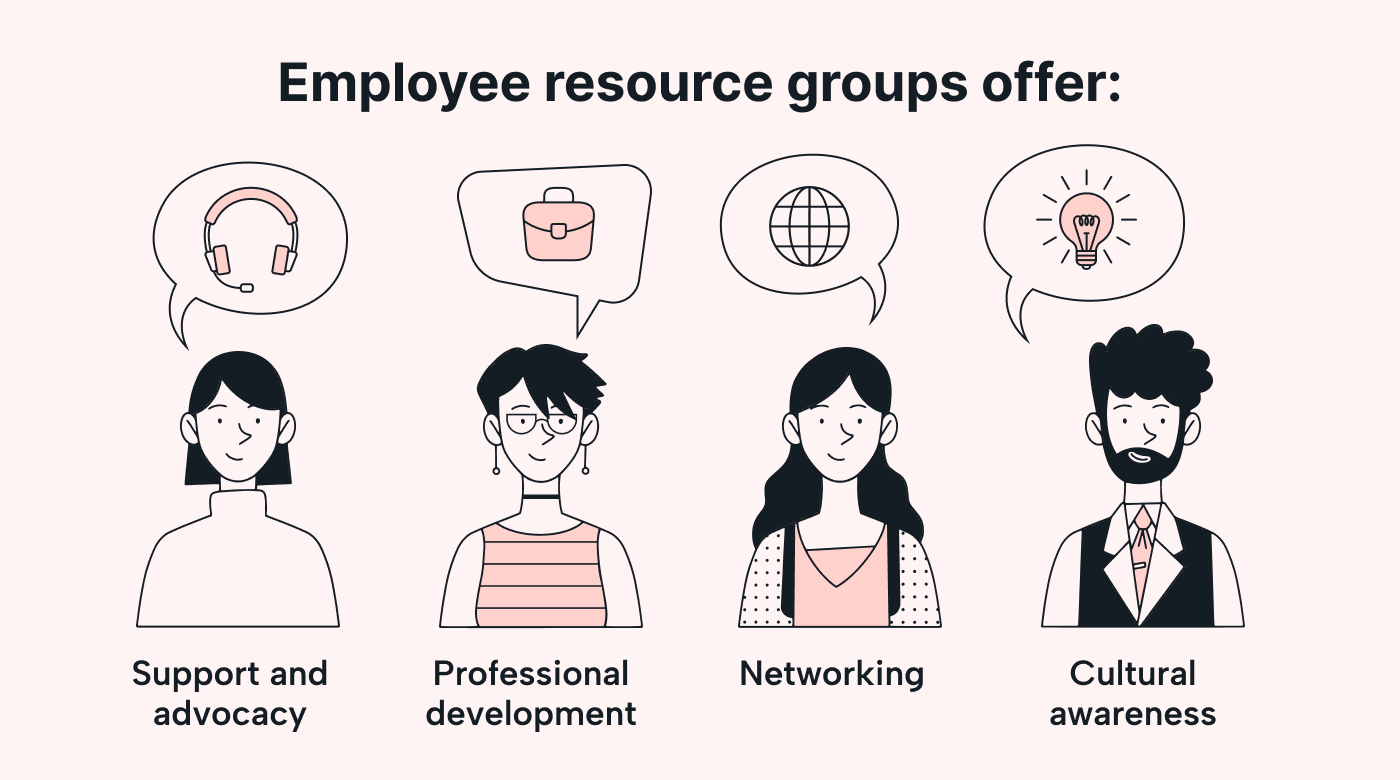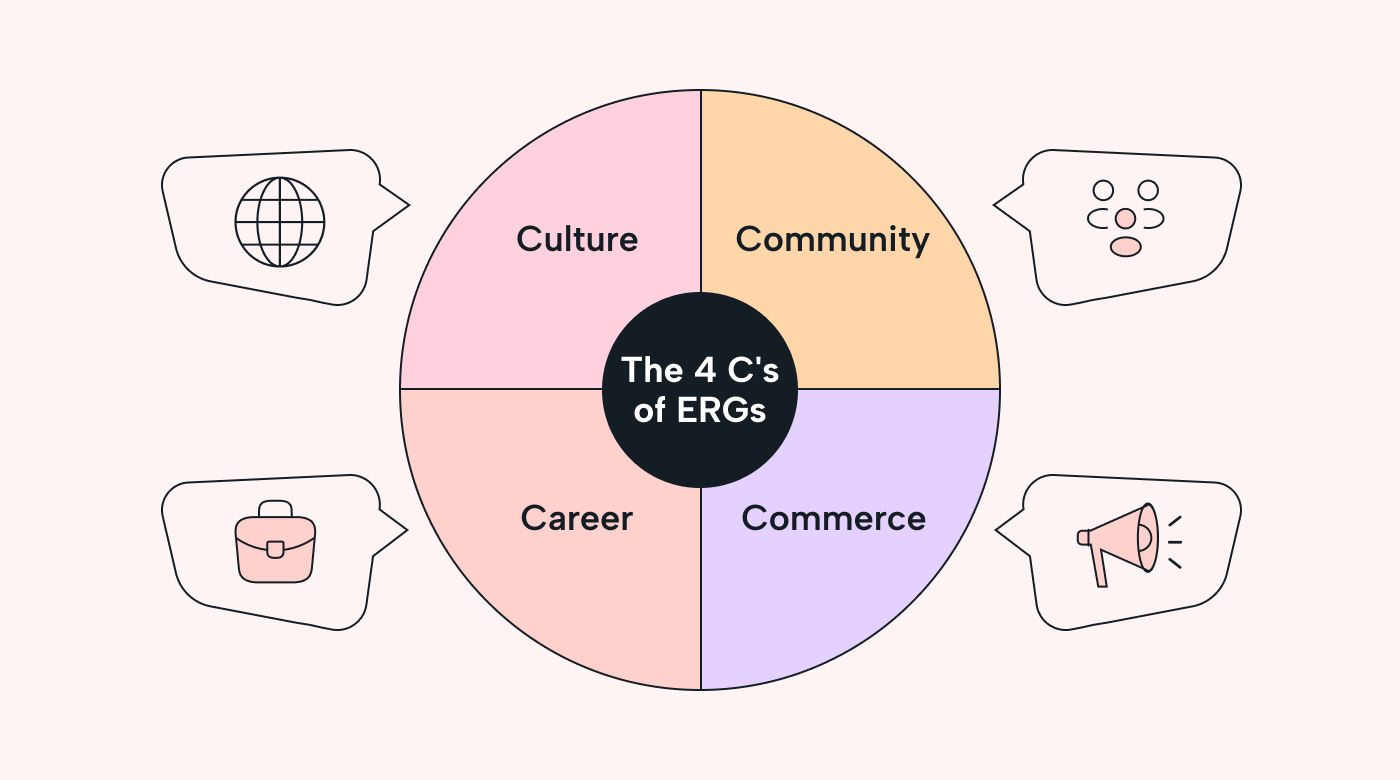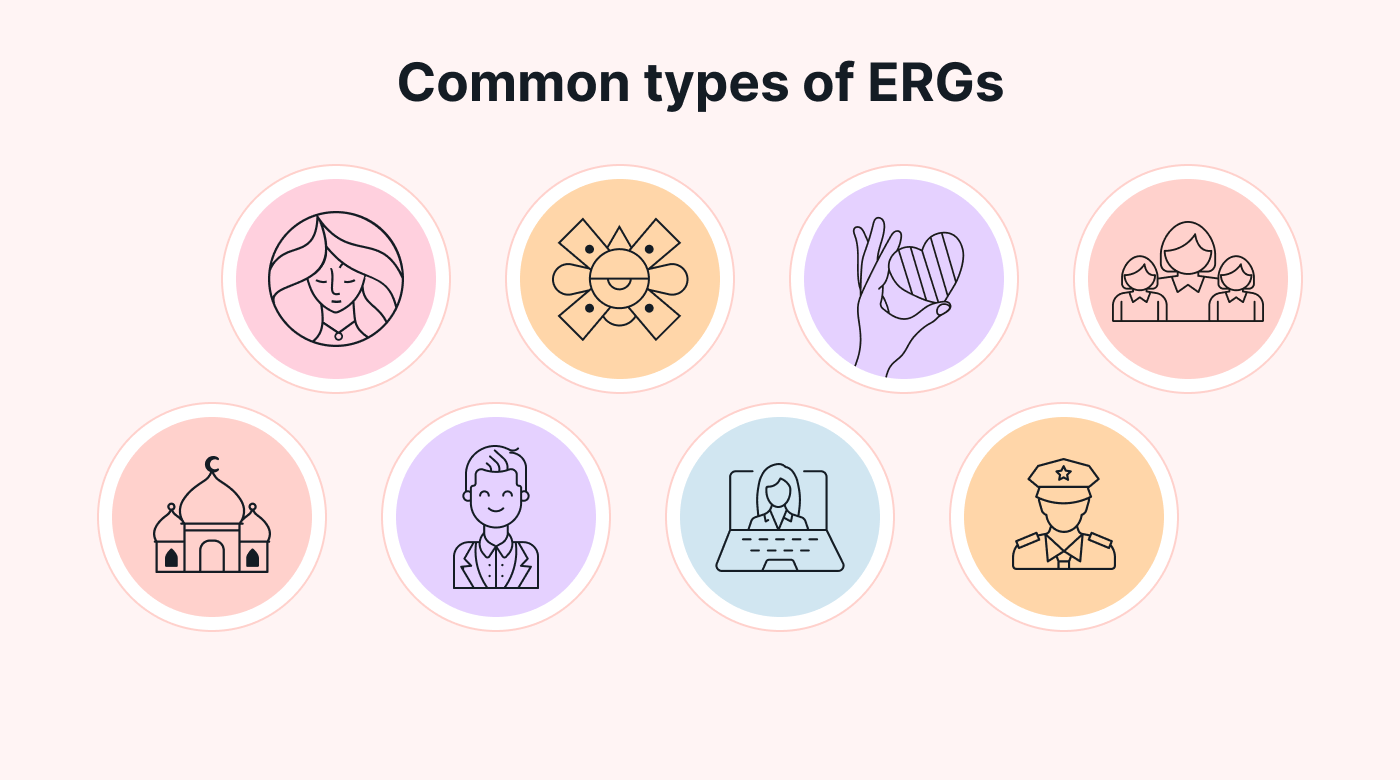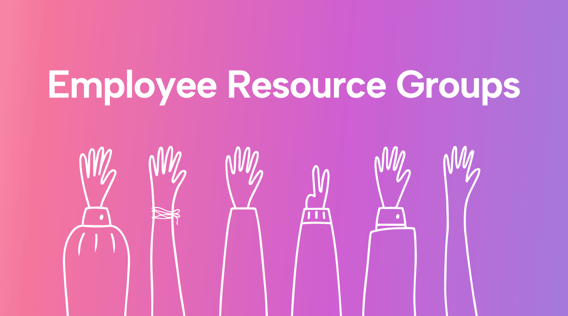Navigating a business landscape can feel like a maze. Shared interests, personal goals, team dynamics — every twist and turn offers a new challenge.
Take a wrong step, and you could feel lost.
Fortunately, employee resource groups (ERGs) serve as guiding stars within the labyrinth. By aligning with groups rooted in shared experiences or backgrounds, you gain direction, amplify your voice, and build bridges with peers on similar journeys.
In this piece, we decode the intricacies of ERGs. Dive into their significance, harness their potential, and learn how they shape your work landscape.
What is an employee resource group?
An ERG is a voluntary, employee-led group within an organization formed around shared characteristics, interests, or life experiences.
ERGs offer members opportunities for professional development, networking, mentorship, and community engagement. They also offer insights into diverse employee populations, helping to shape company policies and improve overall employee engagement and retention.
While ERGs are beneficial for large companies, they have unique advantages for small companies, too. First, they promote inclusivity and diversity, both of which are essential for innovation in small, agile companies. Second, they offer a platform for employees to share their ideas and concerns, enhancing their sense of belonging and empowerment. This is especially crucial in small firms, where each person’s impact is always significant.
What does an employee resource group do?
An ERG performs several functions within an organization, including the following:
 |
Support and advocacy
ERGs aren’t just social groups — they are vital for fostering a supportive community within the workplace. Members can share and address common challenges, creating a safe space for open dialogue to take place.
These groups also play a crucial role in advocating for inclusive company policies. They can highlight the specific needs and perspectives of their members, influencing policy changes that make the workplace more accommodating and fair for everyone.
Professional development
ERGs often organize different skill-building activities, like training sessions, workshops, and seminars. These events are tailored to help members acquire new competencies, prepare for leadership positions, or advance in their current roles.
The learning opportunities ERGs provide are particularly valuable in small companies, where personal and professional growth are closely intertwined.
Networking
Networking is a central feature of ERGs since these groups give employees the space to connect across various departments and hierarchical levels. Cross-sectional networking can lead to mentorship opportunities, project collaboration, and a better understanding of the company’s operations and culture.
Cultural awareness
ERGs enhance cultural awareness in the workplace by organizing events and celebrations related to various cultures, traditions, and histories. Doing this not only celebrates diversity but also fosters a more inclusive and understanding work environment — which is particularly impactful for building a cohesive, respectful, and globally aware team.
What are the 4 C’s of employee resource groups?
The 4 C’s of ERGs encapsulate the primary objectives and value propositions of ERGs within an organization. They are as follows:
 |
1. Culture
ERGs help promote a diverse and inclusive company culture by encouraging different perspectives and an environment of respect and understanding. By doing so, they help create a workplace that is welcoming for all employees.
2. Community
ERGs are all about creating a space where people feel they belong. This means they celebrate the diversity of cultural, gender, age, and group-specific characteristics.
ERGs make employees more aware and appreciative of different perspectives by organizing events and discussions around these topics.
3. Career
ERGs aren’t just about discussions; they’re also a goldmine for networking, finding mentors, and picking up new skills. They create a space for employees to learn, get noticed, and maybe even climb the career ladder a bit faster.
4. Commerce
ERGs contribute to a company’s bottom line by providing insights into diverse consumer markets and product development. This may improve employees’ understanding of different markets, which can help the company connect with a wider range of customers.
An inclusive company culture also plays a role in hiring and retaining employees, which can have a knock-on effect on the company’s financial success. Eighty-six percent of job seekers believe that a company’s approach to diversity, equity, and inclusion (DEI) initiatives is an important factor when considering an employer.
What are the benefits of joining an employee resource group?
Joining an ERG offers a range of benefits that can enhance both the company and an individual’s professional life within that company. Let’s delve into these advantages.
Sense of belonging
ERGs create a welcoming space for employees. Within these groups, you can find others who share similar experiences or interests, making even larger organizations feel more like close-knit communities.
This sense of belonging is crucial, especially in a large workplace.
Professional development
ERGs are a hub for growth, as they frequently organize workshops, training sessions, and seminars. These events are golden opportunities for employees to sharpen their skills and aim higher with their career goals.
Networking opportunities
ERGs create avenues for members to interact with colleagues from various departments and levels. This promotes valuable networking and mentorship opportunities.
 |
Advocacy
ERGs are a great way for employees to have their voices heard. They advocate for their members’ needs and concerns, pushing company policies and practices to be more inclusive and considerate of diverse groups.
Leadership opportunities
Active involvement in ERGs can lead to leadership roles within the group. This makes them a fantastic way for employees to hone their leadership skills in a relatively low-risk environment.
Enhanced job satisfaction
Being part of an ERG can boost an employee’s engagement and morale at work, possibly leading to higher job satisfaction. This connection comes from being part of a group that shares your values and interests.
Feedback channel
ERGs provide a platform for members to express their concerns, ideas, or feedback. They can act as a bridge between regular employees and the organization’s leadership, ensuring that everyone’s voices are heard and considered.
Common challenges that employee resource groups face
While ERGs offer many benefits, there are potential disadvantages or challenges associated with them. Here are a few:
Becoming inactive and outdated
One of the biggest challenges for ERGs is maintaining momentum and relevance. Over time, without consistent engagement and new initiatives, these groups can lose their vibrancy and impact.
It’s essential for ERGs to continuously refresh their goals, attract new members, and engage in activities that resonate with current workplace and societal issues. This requires proactive planning and a willingness to adapt to changing dynamics within the organization and the broader community.
Gaining executive support and buy-in
Executive backing is crucial for the success of ERGs. These groups need the support of senior leaders for resources, visibility, and influence. However, securing this support can be challenging, especially in organizations that don’t immediately recognize the value of ERGs.
Demonstrating the tangible benefits of ERGs, such as improving employee engagement, contributing to a positive workplace culture, and providing insights into diverse markets, can help a company gain this crucial support.
Avoiding tokenism
ERGs can be perceived as mere symbolic efforts toward diversity and inclusion rather than substantive agents of change. This perception undermines these groups’ objectives and can lead to cynicism among members and non-members alike.
To help avoid this, ERGs should focus on creating meaningful, measurable changes within the organization. For instance, they could influence policy changes or business strategies, as well as actively participate in community outreach efforts.
Balancing voluntary participation with genuine effort
It’s important that participation in ERGs is seen as voluntary and driven by a genuine interest in promoting diversity and inclusion. If involvement is perceived as mandatory or simply a checkbox activity, this can dilute the authenticity and passion that drives these groups.
Encouraging voluntary participation while emphasizing the value and impact of these groups can help maintain their integrity and effectiveness.
Ensuring representation without segregation
While ERGs aim to provide representation for diverse groups, they must be careful not to inadvertently create divisions within the company.
This is a delicate balance to maintain — celebrating diversity and providing a platform for underrepresented voices while ensuring that these efforts don’t lead to a sense of segregation or an “us vs them” mentality.
ERGs should strive to be inclusive, fostering understanding and collaboration among all employees and emphasizing the common goals and values that unite the workforce.
Common types of employee resource groups
Many different ERGs exist, but some are more common than others. Let’s check out a few of the most popular ones.
 |
1. Women’s ERGs
These groups focus on addressing the unique challenges and needs women face in the workplace, promoting professional development, and advocating for gender equality.
2. Racial and ethnic ERGs
These groups cater to specific racial or ethnic backgrounds and can include:
- African or African-American ERGs
- Hispanic or Latino ERGs
- Asian or Asian-American ERGs
- Native American ERGs
3. LGBTQ+ ERGs
These groups support lesbian, gay, bisexual, transgender, and queer employees by addressing the unique challenges they face, promoting inclusion, and raising awareness about LGBTQ+ issues.
4. Working parents ERGs
These groups support employees who balance work with parenting, offering them resources and creating a community for sharing common experiences and challenges.
5. Religious ERGs
These groups are formed around specific religions or belief systems, providing a space for members to connect and celebrate their faith while also educating others about their traditions.
6. Young professional ERGs
These groups focus on the needs and development of younger employees, offering them mentorship, networking, and professional growth opportunities.
7. Remote worker ERGs
These groups address the unique challenges and needs of employees who work remotely or in non-traditional office settings.
8. Veteran ERGs
These groups provide support and resources for employees who have served in the military, assisting with their transition to civilian work life and recognizing their contributions.
Key elements of a successful ERG
What does it take for an ERG to run smoothly and achieve its objectives? Here are some foundational elements of successful ERGs:
Strong leadership
Leadership drives the direction, momentum, and overall impact of an ERG. Effective leaders can inspire members, advocate for the ERG’s objectives, and ensure the group remains aligned with the broader company goals.
Look for leaders who are passionate about the ERG’s cause and have a vision for its future. ERG leaders should also have the skills to motivate and guide the group’s members. Offering leadership training can also be beneficial.
Clear mission and objectives
A well-defined mission provides direction and purpose, ensuring that all activities and initiatives align with the group’s core goals.
Collaborate with ERG members to draft a clear mission statement. Set short- and long-term objectives, regularly reviewing and adjusting them based on evolving needs and feedback.
Budget and resources
Adequate funding and resources enable ERGs to host events, run programs, and take on initiatives that further their mission.
Establish a dedicated budget allocation from the company. Consider external sponsorships or partnerships, if allowed. Ensure transparency in how resources are used and highlight the ROI of the ERG’s activities to secure continued support.
Actively involved members
Engaged members are the lifeblood of any ERG. Their active participation ensures the group remains vibrant, relevant, and impactful.
 |
Create an inclusive environment where all members feel valued and heard. Host regular meetings, events, and feedback sessions. Recognize and celebrate member contributions to foster a sense of ownership and commitment.
Keep your employee resource groups on track with Motion
ERGs are a shining example of diversity, inclusion, and empowerment in today’s ever-evolving professional landscape. They go beyond enhancing the corporate culture to drive both personal and professional development among staff members.
Imagine an environment where the seamless integration of technology and human collaboration means ERGs don’t just survive but thrive.
Motion offers just that — a platform where scheduling meetings, managing tasks, and maintaining ERGs’ momentum become effortless and intuitive.
With Motion, companies can ensure their ERGs make a positive impact and succeed.
Ready to hear more? Sign up for a free 7-day trial.





